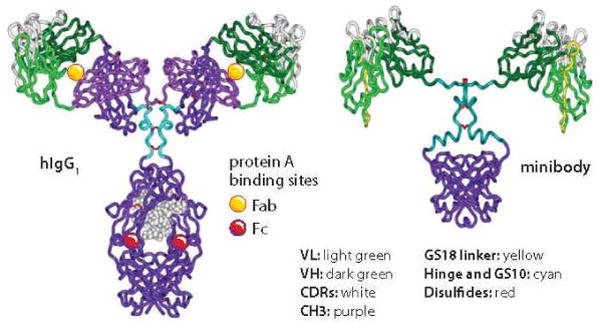What is Minibody
Minibody is a genetically engineered antibody fragment that consists of two single-chain antibodies (scFv) linked by the human IgG1 CH3 region. It possesses the ability to bind antigens bivalently. Compared to full-length antibodies, Minibody offers several advantages, including small molecular weight, good penetration, fast clearance, and high targeting. It finds extensive applications in biomedicine, especially in tumor diagnosis and treatment. In these applications, Minibody can serve a carrier for radioactive isotopes, drugs or toxins. It can also fuse with cytokines to form immunocytokines, thereby enhancing the killing effect on tumor cells.

Fig.1 Structural Comparison of a Human IgG1 and an Anti-PSCA Minibody (Gagnon P, 2010)
Generation Methods of Minibody
Minibody is generated by genetically fusing of a single-chain antibody (scFv) to the human IgG1 CH3 domain. The scFv comprises the variable regions of the immunoglobulin heavy and light chain, covalently linked by a peptide linker. The CH3 domain mediates the dimerization of the scFv, resulting in a bivalent antibody fragment with a molecular weight of about 80 kDa. To enhance the heterodimerization efficiency and stability of Minibody, single-residue mutations or additional cysteine residues can be introduced into each CH3 domain to achieve the "knobs and holes" approach. Minibody can be expressed in various host cells, such as bacteria, yeast, insect cells, or mammalian cells. It can then be purified using different chromatography methods, including multimodal chromatography (MMC), hydroxyapatite chromatography, or affinity chromatography.
Clinic Status of Minibody
Minibody, with its high targeting capabilities and rapid clearance rate, has been utilized in clinical trials for various types of tumors. For instance, [124I] PSCA-Minibody is a Minibody designed to target the prostate stem cell antigen (PSCA). It has been used for positron emission tomography (PET) imaging of prostate cancer, pancreatic cancer and bladder cancer. The purpose of these trials was to evaluate the tumor targeting characteristics and safety of [124I] PSCA-Minibody in patients with these types of tumors. The results showed that [124I] PSCA-Minibody effectively bound to PSCA-positive tumor cells, exhibited low blood and normal tissue uptake, and provided a good signal-to-noise ratio and image quality.
Another example is [89Zr] huA33-Minibody, which targets the human gastrointestinal antigen (huA33). This Minibody has been employed for PET imaging of colorectal cancer and gastric cancer. The purpose of this trial was to assess the pharmacokinetics, dose-effect relationship, and safety of [89Zr] huA33-Minibody in patients with these types of tumors.. The results indicated that [89Zr] huA33-Minibody achieved maximum tumor uptake within 24 hours, showed a positive correlation with huA33 expression level, had low blood and normal tissue uptake, and delivered excellent image contrast and resolution.
These clinical trials illustrate the potential of Minibody, a novel radiolabeled antibody fragment, in tumor diagnosis and treatment. Minibody not only offers high sensitivity and specificity for tumor imaging but also facilitates the evaluation of tumor surface antigen heterogeneity and dynamic changes. This information can guide personalized and precise treatment decisions. Additionally, Minibody can function as a drug carrier or immunomodulator when combined with radioactive isotopes, drugs, or cytokines, etc., thereby enhancing the killing effect on tumor cells. Consequently, Minibody demonstrates broad application prospects and innovation value in clinical trials.
Minibody products currently available on the market primarily consist of radiolabeled antibody fragments for tumor imaging. These products provide high sensitivity and specificity for tumor detection and evaluation. Several Minibodies have already been approved or authorized in different countries and regions, mainly targeting prostate cancer, pancreatic cancer, colorectal cancer and gastric cancer.
Table 1. Minibody Products Already on the Market or Upcoming
|
Product Name
|
Target
|
Disease
|
Approval/ Authorization Time
|
Indication
|
Population
|
Country/ Region
|
|
[124I] PSCA-Minibody
|
Prostate stem cell antigen (PSCA)
|
Prostate cancer, pancreatic cancer, bladder cancer
|
2020
|
PET imaging
|
Metastatic or recurrent tumor patients
|
USA
|
|
[89Zr] huA33-Minibody
|
Human gastrointestinal antigen (huA33)
|
Colorectal cancer, gastric cancer
|
2021
|
PET imaging
|
Locally advanced or metastatic tumor patients
|
Australia
|
|
[18F] PSMA-Minibody
|
Prostate-specific membrane antigen (PSMA)
|
Prostate cancer
|
2022 (expected)
|
PET imaging
|
High-risk or recurrent tumor patients
|
EU
|
References
1. Ziller F, et al. Minibody: A novel engineered anti-carcinoembryonic antigen antibody fragment (single-chain Fv-CH3) which exhibits rapid, high-level targeting of xenografts. Cancer Res. 1997 Jul 1;57(13):2723-9.
2. Olafsen T, et al. ImmunoPET using engineered antibody fragments: fluorine-18 labeled diabodies for same-day imaging. Tumour Biol. 2012 Aug;33(4):669-77.
3. Olafsen T and Wu AM. Antibody vectors for imaging. Semin Nucl Med. 2010 Jan;40(3):167-81.
4. Kenanova V, et al. Tailoring the pharmacokinetics and positron emission tomography imaging properties of anti-carcinoembryonic antigen single-chain Fv-Fc antibody fragments. Cancer Res. 2005 Jan 1;65(1):622-31.
5. Olafsen T, et al. Optimizing radiolabeled engineered anti-p185HER2 antibody fragments for in vivo imaging. Cancer Res. 2004 Jul 15;64(14):4870-9.
6. Olafsen T, et al. Recombinant anti-carcinoembryonic antigen diabodies for radioimmunotherapy of colorectal cancer: evidence for improved targeting compared with intact antibody. Cancer Biother Radiopharm. 2002 Oct;17(5):541-53.
7. Olafsen T, et al. Characterization of engineered anti-p185HER2 antibody fragments (single-chain Fv and diabody) expressed in Escherichia coli and Pichia pastoris. Protein Eng Des Sel. 2004 Jul;17(4):315-23.
8. Gagnon P, et al. Minibodies and Multimodal Chromatography Methods: A Convergence of Challenge and Opportunity. Bioprocess Int. 2010 Feb;8(2):26-35.
Our products and services are for research use only, and not for use in diagnostic or therapeutic procedures.
Welcome! For price inquiries, we will get back to you as soon as possible.
To order, please email
INQUIRY









